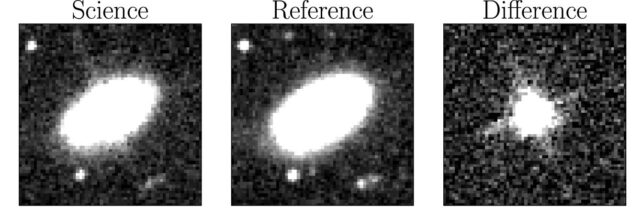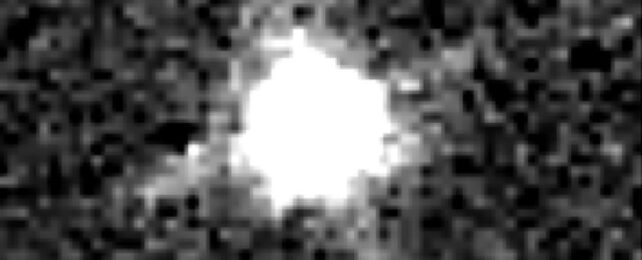The rarely seen moment a black hole catches and devours a star has been spotted at the closest proximity yet.
In a galaxy named NGC 7392 located just 137 million light-years away, a quarter of the distance of the previous record, astronomers captured the scream of light as a supermassive black hole first pulled apart then swallowed a star.
Moreover, it's the first such event captured in unconventional light. Rather than optical or X-radiation, the event, named WTP14adbjsh, was seen as a bright infrared flare.
The discovery suggests that there could be such tidal disruption events (TDEs) out there that we're missing, simply because we're not looking in the right part of the electromagnetic spectrum. And this could solve a curious puzzle about the TDEs we have detected to date.

"Finding this nearby TDE means that, statistically, there must be a large population of these events that traditional methods were blind to," says astrophysicist Christos Panagiotou of MIT's Kavli Institute for Astrophysics and Space Research.
"So, we should try to find these in infrared if we want a complete picture of black holes and their host galaxies."
Black holes, if they're not actively accreting material, are hard to spot. They're so dense that spacetime curves in around them, creating a gravitational trap from which not even light can escape. This renders them effectively invisible to our light-sensitive instruments, the eyes with which we explore the cosmos.
But an active black hole is a messy eater. The violent processes of accretion in the extreme gravitational regime around them generate incredible amounts of light. Any star that wanders too close will first be distorted, then pulled apart by the tidal force of the gravitational interaction, before falling down onto the black hole as a rain of debris.
Here on Earth, we can see this as a bright flare and gradual fading of light as the star erupts and then dies, usually strongest, and first spotted, in X-ray and optical light.
WTP14adbjsh, by contrast, did not ping any of the telescopes set up to detect the X-ray and optical flares that are usually the telltale signs of a TDE.
Rather, Panagiotou and his colleagues found it in archival data collected by the NEOWISE spacecraft in 2014 and 2015, an infrared space telescope that scans the skies looking for asteroids and comets in the Solar System.
"We could see there was nothing at first," Panagiotou says. "Then suddenly, in late 2014, the source got brighter and by 2015 reached a high luminosity, then started going back to its previous quiescence."
Looking through other data of that region of the sky at the time of the flare collected by the MAXI (X-rays) and ASAS-SN (optical) surveys showed that WTP14adbjsh wasn't visible in those wavelengths at all.
Nevertheless, the way the light flared and faded was exactly consistent with the evolution of a TDE, around a supermassive black hole around 30 million times the mass of the Sun.
And this is where things get really interesting.
Most of the TDEs detected to date have been found in a relatively rare galaxy type. These are older, staid galaxies that don't have a lot of gas and dust in the space between the stars.
Nor do they have a lot of star formation going on; sort of 'goldilocks' galaxies, between the star-forming galaxies that are dusty and fairly busy with star formation, and the quiescent galaxies that seem to have finished with all that star-forming business, and are happy just peaceably drifting through space.
If we expect TDEs to occur anywhere, it's the star-forming galaxies, which are the most numerous in the Universe. That's because the stars they're churning out are expected to provide plenty of material for a black hole to tidally disrupt.
However, we've found relatively few TDEs in galaxies of this type, despite their preponderance.
WTP14adbjsh suggests a reason why. Star-forming galaxies have a lot of dust obscuring their centers. X-ray and optical light would not be able to penetrate this dust. But infrared light, with its longer wavelengths, doesn't scatter off dust particles the way shorter wavelengths do. It can travel straight through, largely unhindered.
So it's not that TDEs prefer host galaxies that don't have dust; it's that we haven't been looking for them in dusty host galaxies using the right tools. This means there could be a whole bold new Universe of dismembered stars screaming in infrared light, just waiting out there for us to find them.
"The fact that optical and X-ray surveys missed this luminous TDE in our own backyard is very illuminating, and demonstrates that these surveys are only giving us a partial census of the total population of TDEs," says astronomer Suvi Gezari of the Space Telescope Science Institute, who was not involved in the research.
"Using infrared surveys to catch the dust echo of obscured TDEs… has already shown us that there is a population of TDEs in dusty, star-forming galaxies that we have been missing."
The findings have been published in The Astrophysical Journal Letters.
